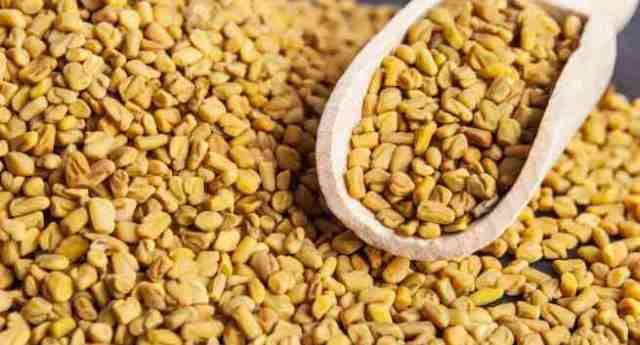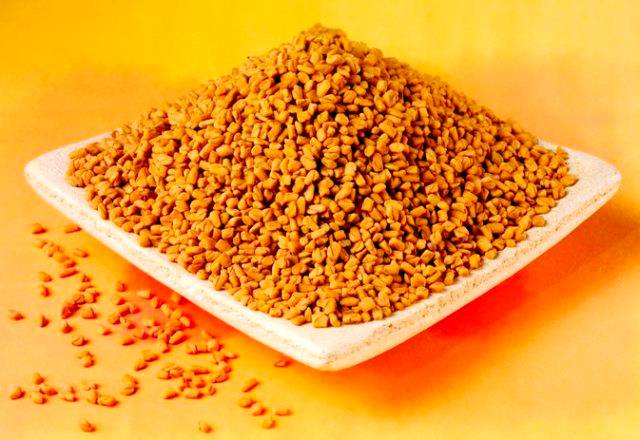
Fenugreek is an important and one of the most popular seed spice crop grown in North Africa, Mediterranean Europe, West and South Asia and parts of Australia. India is the largest producer and exporter of this crop in world. Both of its leaf and seeds are commonly used by the people in their daily diet. Not only for culinary purpose, but it has an extensive use in production of confectionery and bakery products. Fenugreek as a crop has a great future in the nutraceutical and functional food industry due to its immense medicinal applications in human and animal health. It helps in digestive, carminative, diuretic, anti-diabetic, hypercholesterolemic, antileukemic, anti-nociceptive, antipyretic and antimicrobial and also a rich source of protein. The medicinal properties attributed to fenugreek have been reported to be associated with its unique phytochemicals, such as complex carbohydrates (galactomannans), steroidal sapogenins (diosgenin, yamogenin, tigogenin, neotigogenin), alkaloids (trigonelline) and amino acids (4-hydroxyisoleucine). Seeds are aromatic, bitter, carminative, galactogouge, antibacterial.
Table 1: Properties of fenugreek
|
Particulars |
Contents (g per 100 g) |
|
Carbohydrates |
42.3 |
|
Gum (Seed) |
20.9 |
|
Fats (leaves) |
1 |
|
Fats (Seed) |
7.9 |
|
Protein (fresh leaves) |
4.4 |
|
Protein (seed) |
25.4 |
|
Fibre (Seeds) |
50 |
|
Soluble |
|
|
1) Raw |
21.7 |
|
2) Germinated |
10.3 |
|
Insoluble |
|
|
1) Raw |
26.8 |
|
2) Germinated |
23.9 |
|
Dietary fibre |
48 |
|
Ash (Seeds) |
3.38 |
In past decades imbalance use of chemical fertilizers containing no micro-nutrients and no use of organic manures are resulting to poor nutrient use efficiency and increase in cost of cultivation. Therefore, inadequate and imbalanced nutrition is one of the leading reasons for poor yield of this crop. For proper growth and development it is necessary to maintain soil fertility. Micronutrient deficiencies are widespread, 50 percent of world soils are deficient in zinc. In Indian soils zinc scarcity is the second most widespread problem next to nitrogen which decreases the crop yield. Deficiency of zinc is one of the major constraints in world food production. Thus the productivity of fenugreek can be enhanced by judicious package of nutrients especially zinc. Fenugreek is a winter season crop; hyper accumulator crop of zinc in the shoot than in root. Fenugreek seeds contained zinc ranged from 1.28 to 2.78 mg/100g with an average of 2.08 mg/100g.

Zinc exerts a great influence on basic plant life processes, such as (i) nitrogen metabolism– uptake of nitrogen and protein quality; (ii) photosynthesis– chlorophyll synthesis, carbon anhydrase activity, pollen function, fertilization and germination. Zinc is a metal component of various enzymes, as a functional structural or regulatory cofactor, for protein synthesis, photosynthesis, the synthesis of auxin, cell division, the maintenance of membrane structure and sexual fertilization. It is essential for the transformation of carbohydrates and synthesis of tryptophan, which act as precursor of vitamin A, regulating consumption of sugars.
Zinc deficiency in plants is most frequently corrected by application of zinc to soils. Several workers reported that zinc is involved in nitrogen metabolism pathway of plants, thus affecting the protein synthesis in zinc deficient plants. Zinc deficiency significantly affects the root system including root development. Zinc deficiency influenced the absorption of water and nutrients from soil by affecting the root development and thus resulting in growth and yield reduction in plants. Under severe deficiency flowering and fruiting process were greatly reduced under severe zinc deficiency. Zinc deficiency can also adversely affect the quality of harvested products; plants susceptibility to injury by high light or temperature intensity and to infection by fungal diseases can also increase.
Identification of causes of zinc deficiency would help in planning the appropriate strategies to correct the deficiency and improve the crop production. Application of zinc fertilizers and use of zinc solubilizing bacteria are desirable to correct zinc deficiency, increase zinc use efficiency and reduce cost of inputs. Zinc deficiency generally occurs in soil having poor fertility, high pH and low organic carbon content. The major reason for the widespread occurrence of zinc deficiency problems in crop plants is attributed to low solubility of zinc in soils rather than a low total amount of zinc. Customary application of inorganic zinc partially caters the plant need as 96–99% of applied zinc is converted into different insoluble forms within 7 days of application and make unavailable to plant hence, it is plausible that exploitation of native zinc mineralizing and solubilizing bacteria may aid in overcoming zinc deficiency and increase availability of zinc to crops by solubilising the complex zinc in soil. These solubilizers also exhibited strong production of ammonia, which can be taken up by plants as a source of nitrogen for their growth. The zinc solubilizer influence the bioavailability of zinc into the soil through the different mechanisms of acquisition of zinc from insoluble zinc compounds viz. consequence of proton extrusion, production of organic acids of microbial origin and subsequent release of zinc in external environment and bioaccumulation of zinc inside cells of bacterial species leading to solubilization of zinc. Acidification (production of organic acids) is the main strategy followed by the zinc solubilizing Bassilus aryabhattai strains for solubilizing insoluble zinc












Share your comments